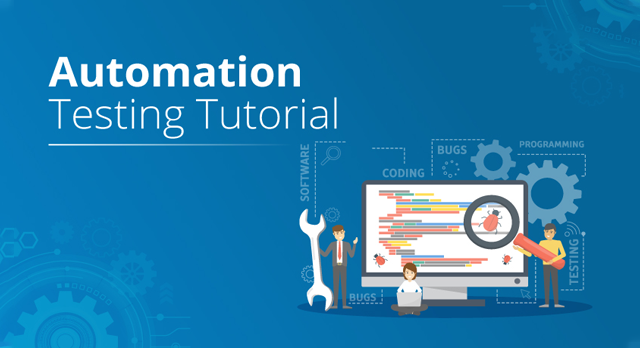Automation Testing: Secret Tips to Streamline Advancement Lifecycles
Automation Testing: Secret Tips to Streamline Advancement Lifecycles
Blog Article
From Handbook to Automated Testing: A Comprehensive Guide to Transitioning Efficiently and Efficiently
In the realm of software screening, the shift from guidebook to automated processes has actually ended up being a progressively vital change for companies looking for to improve efficiency and accuracy in their screening techniques. As technology remains to advancement, the demand for seamless and effective automated testing techniques has never ever been extra pressing. The journey from manual to automated testing is not without its obstacles, yet when come close to tactically and with a clear strategy in mind, the benefits can be significant - automation testing. In this detailed guide, we will explore crucial steps and considerations essential for an effective change, from the first option of tools to the integration of automation into existing workflows. Stay tuned to uncover the understandings that will certainly assist lead the way for a smoother and extra reliable screening process.
Advantages of Automated Checking
Automated testing supplies countless advantages, improving efficiency and accuracy in software program development processes. One main benefit is the considerable decrease in screening time. Automated tests can be run simultaneously on several gadgets and operating systems, considerably accelerating the screening stage compared to hand-operated screening. This boosted performance permits faster comments on the quality of the software program, allowing developers to identify and attend to issues immediately.
Furthermore, automated screening guarantees a higher level of precision in discovering flaws. Consistency in testing is additionally boosted, as automated examinations perform the exact same actions precisely each time they are run.
Selecting the Right Tools

First of all, analyze your purposes and requirements. Comprehend the range of your job, the innovations included, and the ability of your team. This analysis will certainly assist you establish the capacities and attributes you require in your testing devices.
Second of all, consider the compatibility of the devices with your existing systems and procedures. Smooth combination with your current software program advancement lifecycle is important to ensure a smooth shift to automation.
In addition, review the scalability and flexibility of the tools. As your screening requires progress, the devices should be able to adapt and accommodate changes successfully.
Finally, consider the support and community around the tools. Robust assistance and an active customer area can provide useful resources and help when implementing automated screening. By carefully taking into consideration these elements, you can pick the right devices that align with your requirements and set the phase for a successful transition to automated testing.
Writing Reliable Test Manuscripts

When crafting test manuscripts, it is necessary to take into consideration the particular demands of the software program being checked and ensure that the manuscripts deal with all essential performances. Clear and descriptive naming conventions for test manuscripts and test instances can boost readability and maintainability. Furthermore, incorporating mistake handling mechanisms within the examination scripts can aid in recognizing and resolving issues immediately.
Moreover, arranging test scripts right into modular components can boost reusability and scalability, minimizing redundancy and improving efficiency in examination script upkeep. Normal evaluations and updates to check manuscripts are critical to equal developing software application demands and capabilities. By following these concepts, testers can develop durable and effective examination scripts that add dramatically to the success of automated screening procedures.
Integrating Automation Into Workflows
Efficient integration of automation tools right into existing operations enhances and enhances processes productivity within software application advancement cycles. When integrating automation right into process, it is essential to determine repetitive tasks that can be automated to save time and decrease human mistake. By perfectly integrating automated testing tools like Selenium or Appium into the software application advancement lifecycle, groups can accomplish faster responses on code changes, leading to quicker insect detection and resolution. This integration permits continual screening throughout the growth process, making sure that any kind of issues are recognized at an early stage, leading to greater software application high quality. Furthermore, automation can be used to trigger examinations instantly after each code commit, supplying immediate recognition and liberating testers to concentrate on more facility circumstances. Appropriate assimilation of automation devices requires partnership site web in between growth, testing, and operations groups to establish a unified operations that optimizes effectiveness and effectiveness in supplying high-grade software products.
Making Sure a Smooth Transition
Successfully transitioning to automated screening includes precise planning and mindful implementation to lessen disturbances and maximize effectiveness in the software application growth process - automation testing. To make certain a smooth shift, it is vital to begin by conducting a comprehensive analysis of the current testing procedures and recognizing areas where automation can bring one of the most considerable advantages. Engaging with all stakeholders beforehand at the same time, consisting of developers, testers, and job managers, is vital for amassing assistance and buy-in for the automation campaign
Interaction is vital during this change stage. Clear interaction of the objectives, benefits, and expectations of automated screening helps to handle any resistance or worries that may emerge. Furthermore, giving ample training and sources for employee to upskill in automation devices and strategies is important for making certain an effective change.

Final Thought
To conclude, transitioning from manual to automated screening offers various advantages, consisting of boosted effectiveness and integrity. learn the facts here now By choosing the appropriate tools, composing efficient test scripts, and integrating automation seamlessly into operations, companies can ensure a successful and smooth shift. It is vital to welcome automation as an important property in software program screening processes to boost total top quality and performance.
In the realm of software program screening, the shift from manual to automated procedures has actually come to be a progressively essential transition for organizations seeking to enhance efficiency and accuracy in their testing practices. Automated tests can be run at the same time on numerous gadgets and operating systems, significantly speeding up the testing stage contrasted to hands-on testing. Consistency in screening is additionally enhanced, as automated tests perform the same actions specifically each time they are run.To make certain the effective application of chosen screening tools, the development of effective examination manuscripts plays a critical role in validating the functionality and performance of automated processes - automation testing. By complying with these concepts, testers can create effective and robust examination manuscripts that add considerably to the success of automated screening procedures
Report this page